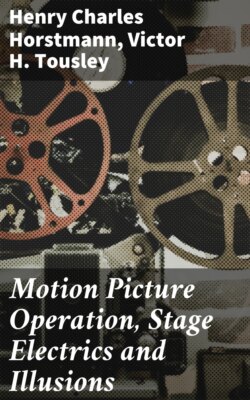Читать книгу Motion Picture Operation, Stage Electrics and Illusions - Henry Charles Horstmann - Страница 21
На сайте Литреса книга снята с продажи.
Current Required for Projecting.
ОглавлениеTable of Contents
Current Required for Projecting.—The value of the current to be used for projection is a matter of some dispute among operators and probably much of this is caused by the absence of ammeters, most operators merely guessing at what they are using, or being guided by markings of rheostats or compensators. In most cases something like 40 amperes seems to be the rule.
In order to give the reader a clear understanding of the theoretical requirements, Table I has been prepared. This table is not intended to act as an accurate guide, but merely to show the amperage theoretically required with different sized pictures, to bring about the same illumination in each case.
TABLE I. CURRENT REQUIRED FOR DIFFERENT SIZE PICTURES.
| Greatest Dimension of Picture in feet. | Area Illuminated. | Amperes | |
|---|---|---|---|
| Direct Current. | Alter- nating Current. | ||
| 5 | 39 | 8 | 12 |
| 6 | 56 | 11 | 16 |
| 7 | 77 | 15 | 22 |
| 8 | 100 | 20 | 30 |
| 9 | 127 | 25 | 37 |
| 10 | 157 | 31 | 45 |
| 11 | 189 | 38 | 57 |
| 12 | 224 | 45 | 67 |
| 13 | 260 | 52 | 78 |
| 14 | 307 | 60 | 90 |
Two errors are very common in the computation of the light intensity for a given picture: (1) the length of throw governs the amperage; and (2) the amperage depends upon the actual space to be illuminated. Apparently only an oblong square of exactly the proportions of the aperture in the machine is illuminated, but in reality the light must be spread out so that its total illumination covers a circle enclosing the actual visible picture. This is illustrated in Figure 23 where the enclosed oblong square represents the space illuminated on the screen and the circle represents the area over which the light must be spread. The portion shown by shading is nearly equal to the clear portion and shows that half of the light is wasted since it is blocked out by the cooling plate in the machine or the framework of the slides. With increasing size of picture, the light is, however, diminished in proportion to the area of the circle and not in proportion to the area of the picture. If, for instance, the picture were to retain its width and be reduced in height by one half, or even more, there would still be about the same quantity of illumination required. For this reason we have, in Table I, given only the maximum dimension of the picture and have based the amperage calculation upon the area of the circle which encloses the picture.
FIGURE 23.
The values given are less than are generally used for small pictures and more than are generally used for large pictures. As a rule much light is wasted on small pictures because the apparatus is at hand to deliver it; with large pictures, the illumination is often poor because transformers and rheostats are seldom fitted to deliver more than 60 amperes. Much light can easily be wasted if the picture is made too bright. In such a case, much of the light is reflected back to the auditorium and this in turn makes the picture appear less bright.
In determining the amperage necessary to show a picture properly, the following conditions must be borne in mind, any one of which may appreciably affect the result:
(1) Nature of Screen.—A good screen will reflect more light than a poor one.
(2) Size of Picture.—The larger the picture, the more light will be required.
(3) Character of Film.—Some films are very dark and require extra illumination.
(4) House Illumination.—In some cities the law requires fairly bright illumination of auditoriums and this makes the picture appear less bright.
(5) Atmosphere.—Where the air is full of dust, or where smoking is allowed; much light will be absorbed.
(6) Lenses.—Some lenses are badly discolored and absorb much light.
(7) Electrodes and Electrode Setting.—This is a very important factor and one which a good operator will never neglect.
